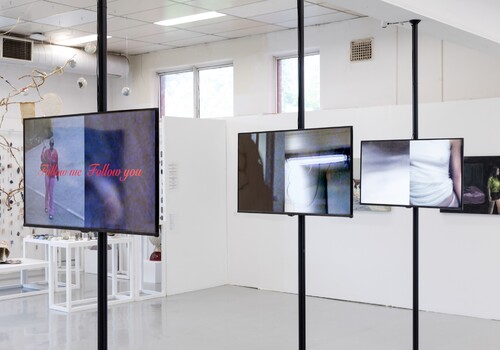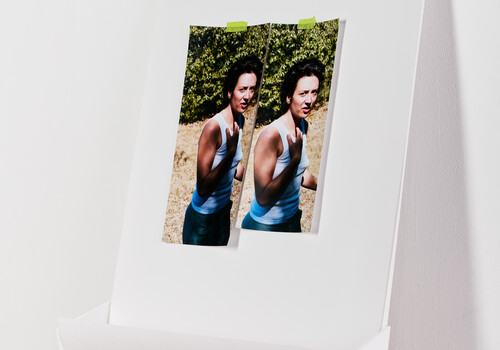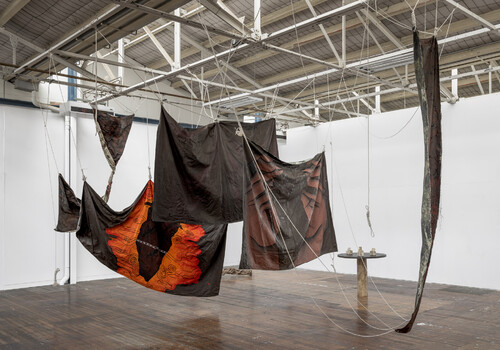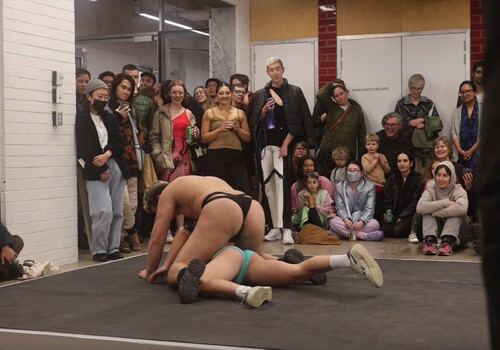Bachelor of Fine Art, MADA
By Teagan Ramsay
Our memories aren’t reflections of our realities. Instead, they are regurgitated culminations of a collection of thoughts and experiences, which have become distorted through our emotions and interpretation of time. Pervaded by haunting atmospheres of anxiety and isolation, the works by MADA graduates Amelia Harte and Jeremee Bautista situate us within the complex space of our own memories—a space where nostalgia and alienation intertwine.
I’ve made peace with the government agent watching me intently through my laptop’s webcam. Despite this, Harte’s A Darkness That Swallows You and Me (2022) prompts me to recall the waves of paranoia that flooded my adolescence, when goosebumps travelled down my spine, when I thought I was being watched or followed. Harte’s video work is fragmented across three free-standing screens placed one behind the other in the middle of the room.

The first screen shows a woman with a Paris Hilton-esque body adorned in a pink Juicy Couture tracksuit, phone glued to her ear, pacing in a carpark. Across the next two screens are blurred close-ups of eyes and mouths contrasted with headless female torsos in white singlets, and predatory visions of a woman walking down an alleyway. The footage on each screen is looped, while a low, distorted voice murmurs indecipherably. The magnified facial features and dehumanised bodies paired with erratic camera movements and jump cuts elicit a menacing atmosphere, one that conjures associations with adolescent voyeurism and surveillance.
Walking down the corridor, a sound bleeds out from a narrow, blanket-covered doorway. I pull the soft fabric aside, propelling my body into the darkness. As my eyes adjust, I’m guided to a rectangular seat illuminated from below by a night light. Here I sit drowning in the sounds of Bautista’s One Night in Neverender (2022), immersed in my own thoughts. The work, which reverberates out of three speakers over a twenty-three-minute loop, weaves together six different soundscapes. These blend together found sounds and samples of bird songs, city traffic, trains, incoming phone calls, murmurs of conversations and the dings of a convenience store sensor bell.

My aural immersion in this composition, coupled with the deprivation of all other senses alienates me from what might otherwise be familiar. By layering and fragmenting ubiquitous sonic cues, Bautista distorts my relationship to activities I associate with these sounds—mundane motions that I often do in solitude, like driving, walking to work, or waiting for friends at a bar. By perverting these remembered sounds Bautista distorts my relationship with time and memory. Similar to memories, Bautista’s work can be revisited and reinterpreted, accentuating my awareness of the fluctuating subjectivity of memory.
When we look back at past experiences, we are often compelled to remember things fondly. However, we rarely publicly share feelings and experiences of grief, isolation and despair. These negative recollections can bury us beneath a layer of discomfort and vulnerability, which can be debilitating. Nonetheless, these emotions and subsequent states of mind create opportunities for self-reflection and transfiguration, as the works of Harte and Bautista so affectingly communicate.
Teagan Ramsay is a Naarm-based (Melbourne) emerging visual artist, curator, and arts worker. Ramsay’s practice explores the complexities of queer memory, desire and experience through methods of queer curating, deep listening and affect.




















